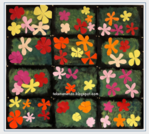
In this Andy Warhol-inspired art project, students attempt to replicate Warhol's original flower artwork.
- Subject:
- Arts Education
- Visual Arts
- Material Type:
- Activity/Lab
- Date Added:
- 06/03/2021

In this Andy Warhol-inspired art project, students attempt to replicate Warhol's original flower artwork.

This site features Louisa May Alcott and Samuel Clemens. See excerpts from Alcott's girlhood journal and Little Women. Read Clemens' explanation of his white suit in Mark Twain's Autobiography and the last chapter of Tom Sawyer, where Huck Finn has fled the Widow Douglas's civilizing influence. Help students see that their own lives and views can be a basis for creative writing.

This paper grid art is a fun way to explore positive and negative shapes, and all you need are a few basic art supplies. The symmetrical shapes and the contrast of the colored paper against the black background makes this project "pop."

Positive and negative space can be tricky concepts to teach. The Japanese art of notan, some simple leaf shapes, and a quick intro to complementary colors is a fun way to explore the idea.

PowerPlay Young Entrepreneurs is a highly engaging program that is designed for classrooms ranging from grades 4 to 8. Students have fun exploring their passions, talents and interests as they plan and carry out their own business ventures. They make real products, earn real money and donate a portion of their profits to charity.For more information about the program, visit powerplayforsuccess.com.

Students create their own monster trading cards using "powerful," vivid language to describe their creatures.

This plant-rooted program contains 6 distinct activities. Students will have the chance to exercise their creativity through botanical drawing and creating a classroom herbarium by pressing and preserving plant specimens. They will learn about plant journeys: from farm to table, and seed dispersal. Finally, they will get to know trees, inside and out, from species identification to age rings.
The Power of Plants is a collection of six complete lesson plans that raises awareness about the importance of biodiversity in everyday life.
o Lesson 1: Two classes - Students will explore these different art forms by creating two artworks using the same plant as a reference. Artists’ statements will express the intentions and design decisions inspired by the art form and floral specimen.
o Lesson 2: - One week - Students will collect and preserve plant specimens to create a class herbarium and explore the different uses for a herbarium.
o Lesson 3: Three classes - In this activity, students will explore some mechanisms used by plants to disperse their seeds by creating model fruit and evaluating the relationship between the fruit’s structure and its dispersal ability.
o Lesson 4: Five classes - Students will explore the concept of “food miles”, visit a farm, farmer’s market, or grocery store and write a newspaper article or editorial summarizing their findings.
o Lesson 5: Four classes - Students will examine the leaves, identify the species, make bark rubbings, measure girth, calculate age, and approximate the height of a single tree. Tree profiles are then collected to create a class encyclopedia.
o Lesson 6: One class - In this activity, students will examine tree rings and discover the secrets preserved within its growth rings.
To access this resource in French, visit https://www.biodiversityeducation.ca/ressources-francaises.html.

Street art fosters and explores the relationships between art, audience, location, and politics.
This inquiry unit has students explore that relationship.

This art history video discussion looks at Fra Andrea Pozzo's "Glorification of Saint Ignatius" ceiling fresco in the nave of Sant'Ignazio, Rome, 1691-1694.

Students will discuss works of art that have grotesque elements and symmetry in their design. They will identify symmetry and line in grotesques. Students will create symmetrical designs for a pilgrim bottle and also design a door panel using grotesques. They will then analyze William Blake's poem "The Tiger" and write their own grotesque-inspired poetry.
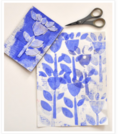
This is a super simple printmaking project for kids. Students cut shapes out of craft foam to glue onto cardboard, creating their own unique collagraph.
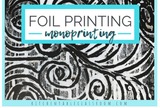
This foil printing method creates monoprints, perfect for beginning "printmakers."

In this resource, the authors describe how to use scratch foam to create easy printmaking projects for kids.
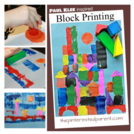
Use a simple set of geometric blocks and paint to create a Paul Klee-inspired piece.

Rainbow anything is beautiful but these leaf prints combine the colors of the rainbow with the delicate details of leaves for a finished product you just want to keep looking at!
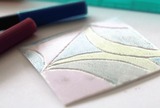
In this lesson, the authors describe how to use washable markers and Styrofoam trays to create unique "prints."

In this lesson, students paint plastic bags, create an image or a pattern in the paint, then "stamp" it onto a fresh piece of paper.

In this 4 lesson unit plan students will examine identity and ways to solve problems of portrayal through caricature. Discussions about the 'beauty myth' self concept and risk taking will be explored as students examine the work of artists and create their personal self portrait.

Students will discuss the sculpture "Python Killing a Gnu" by Antoine-Louis Barye. They will use their imagination to visualize a setting for the python depicted in sculpture. Then they will describe their setting, sculpt a clay snake, and create their setting using mixed media.

To continue to raise awareness and showcase our love for one another a colouring book was created.
This initiative brought together Indigenous artists of all ages to contribute their work that focuses on Indigenous culture, safety, and honouring those affected by MMIWG2S+.